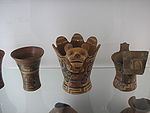 | ||
In archaeology, a horizon is a distinctive type of sediment, artefact, style or other cultural trait that is found across a large geographical area.
The term is used to denote a series of stratigraphic relationships that constitute a phase, or are part of the process of determining the archaeological phases of a site. An archaeological horizon can be understood as a break in contexts formed in the Harris matrix, which denotes a change in epoch on a given site by delineation in time of finds found within contexts.
An example of a horizon is the Dark earth horizon in England, which separates Roman artefacts from medieval artefacts and which may indicate the abandonment of urban areas in Roman Britain during the 2nd to 5th centuries. The term is also frequently used in the archaeology of Pre-Columbian America.
The term 'Archaeological horizon' is sometimes, and somewhat incorrectly, used in place of the term layer or strata.
